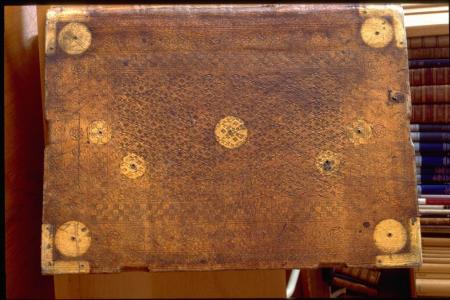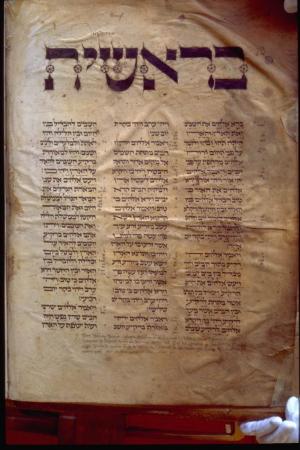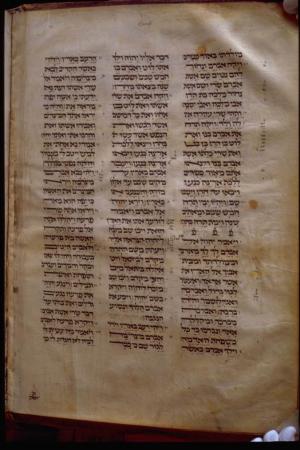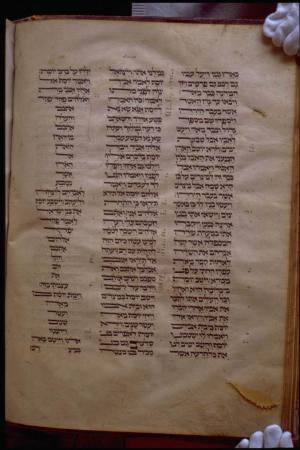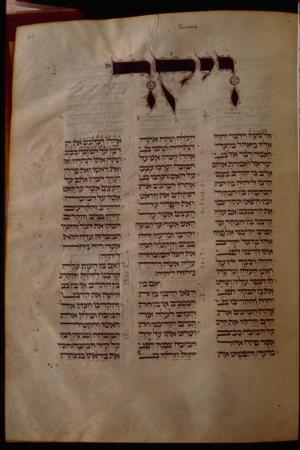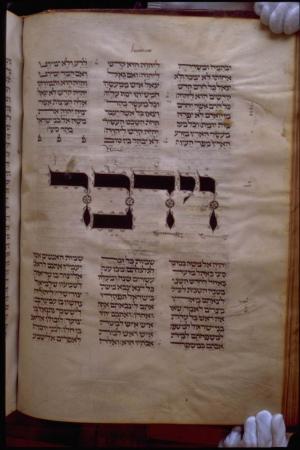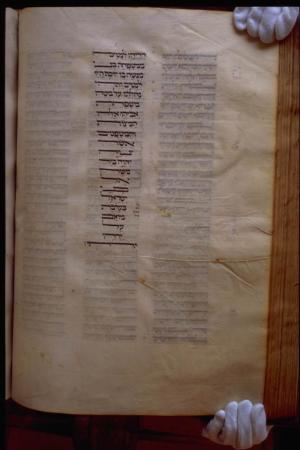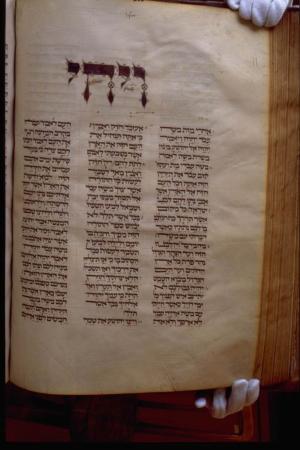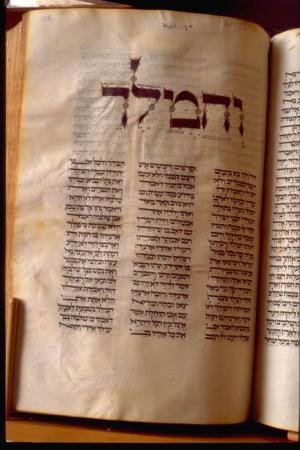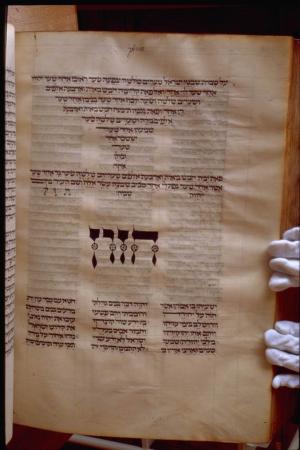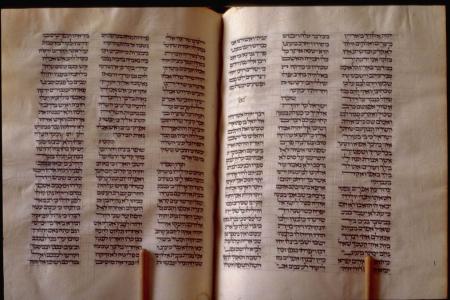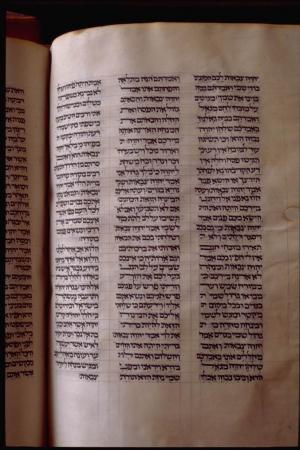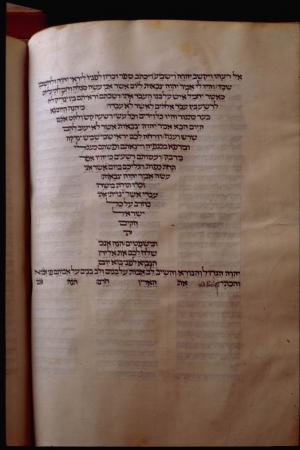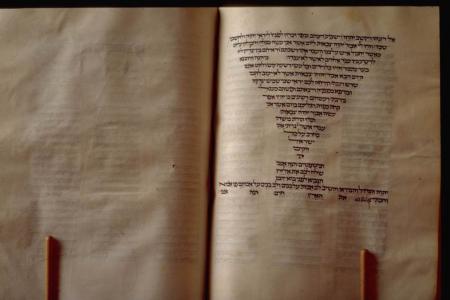Obj. ID: 1521
Hebrew Illuminated Manuscripts Shlomo Halevi Vienna Bible, Germany, 1344
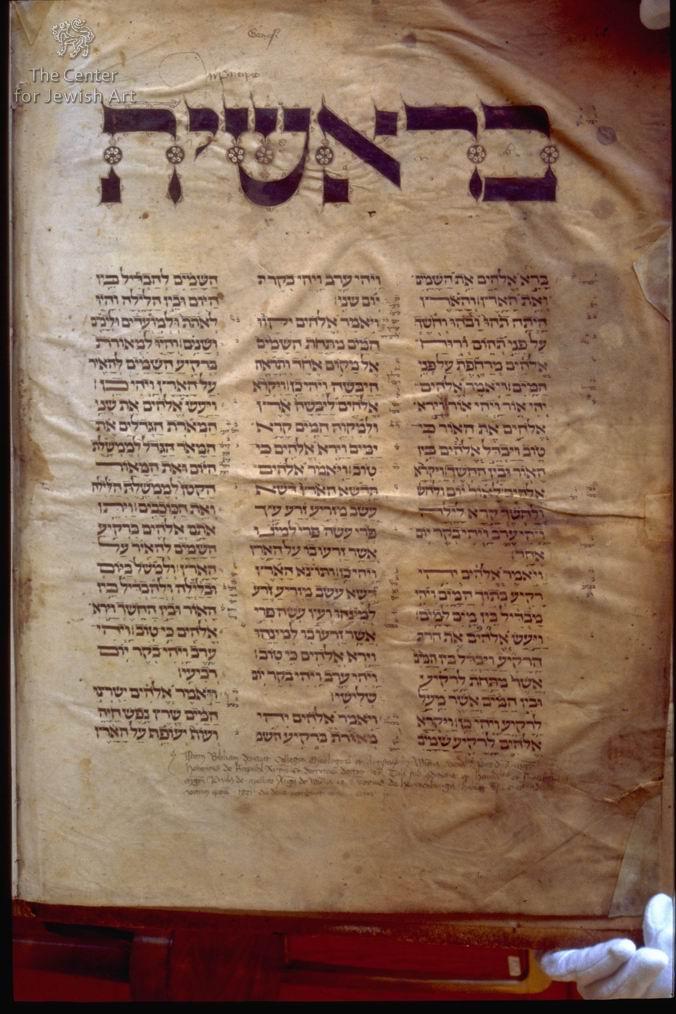
Remarks
This manuscript including the twenty-four books of the Bible was copied by the scribe Shlomo bar Isaac Halevi in Ashkenazi script. He concluded the manuscript with a colophon where he mentions his name, the name of the patron, R. Pfeffercorn, and gives the date of production as 7th of August, 1344.
This Bible is very large (ca. 475-354 mm; 508 leaves) and in that, it joins earlier giant Ashkenazi Bibles of the 13th and beginning of the 14th century, such as the "Ambrosiana Bible", Ulm?, 1236-1238 ( full size:453 x 434 mm; Milano, Biblioteca Ambrosiana, Mss. B 30-32 INF;) and the Shneur ben Hayyim Bible, Germany, Franconia?, 1304 (full size: (445-450) x (320-330)mm; Paris, BN, Hebr. 8-10)[1] As seen in these Ashkenazi Bibles and Pentateuchs, our manuscript is written in three columns vocalized and punctuated and include the massorah parva (see other large Bibles and Pentateuch of the Austrian National Library collection with the text written in three columns: Cod. Hebr. 5 and Cod. Hebr. 9 (cat. XXX). The text of the massorah magna, which is traditionally written in a few lines above the main text and a few lines below it (usually 2+3 or 3+4 lines), is missing in our manuscript. However, since the manuscript includes ruling of 3 lines above the main text and 4 lines below we can deduce that originally it was planned to include the massorah magna which was never copied. The Targum, which commonly appears in the text of the Ashkenazi Bible and Pentateuch, is not included in our manuscript.
The manuscript is simply decorated by the scribe, mainly at the initial word of each of the 24 books of the Bible. The initial words are written in a display script decorated at the junctions of the letters with medallions enclosing rosettes in spared-ground technique. Similarly decorated many other Ashkenazi manuscripts of this period such as the Bible probably produced in Ulm?, in 1286 (Paris, BN, Hebr 1-3, Hebr. 1: fol. 73v; Hebr. 2: fol. 77v; Hebr. 3: fol. 1; see: Gabrielle Sed-Rajna, Les Manuscrits Hébreux, cat. 70, pp. 181-183.), or Shmuel of Schörndorf Pentateuch of the 14th century (ÖNB, Cod. Hebr. 9, e.g. fols. 41v, 80, 92v; see Cat. XXX). It is also decorated with shaped text at the end of many books of the Bible.
In Elul 1419 the manuscript moved to the hands of Shlomo son-in-law of R. Eliezer (fol. 1; See: History). Later on it reached non-Jewish hands as is evident from the many Latin inscriptions (See: History). Later on it reached the Austrian National Library at ???.- Ask Fingernagel.
[1] For the characteristic of the Ashkenazi Bible see: Sarit Shalev-Eyni, Jews among Christians, (forthcoming publication),
sub-set tree:
Material: Parchment, 508 leaves
Hard to distinguish between hair to flesh sides.
Measurements
|
Full page: (472-479) x (352-355) mm |
|
Text space: (313-322) x (233-234) mm |
|
Column’s width: 62-67 mm |
|
Intercolumnar space: 19-24 mm |
Scribes
Single scribe.
Script
|
Square Ashkenazi script in dark brown ink. |
Columns
Written in three columns except for Moses’ first song written in one column (written in a brickwork pattern) (fol. 43v-44)
Number of lines
|
Main text written: |
In 31 lines per column |
Ruling
Ruling by brown plummet (similar to ink on fols. 1-205v and 209-220v ) and gray plummet (fols. 206-208v, 221-508).
Horizontal lines:
- Fols. 1-349v: 3 + 32 + 4 horizontal lines. ( The 3 ruled lines on top and 4 on bottom are probably for the massorah magna to the text which was never written (the pricking is also of 3 + 32 + 4 pricks).
-
- Fols. 350-505v, 506v-508: 32 horizontal lines.
- Fol. 506: 32 double horizontal lines.
Vertical lines:
- Fols. 1-414v, 439-end: 1 + 3 + 3 + 1+ 1 vertical lines on the recto sides and 1 + 1+ 3 + 3 + 1 vertical lines on the verso sides
- Fol. 209v: 1 + 1 + 2 + 3 + 2 + 3 + 2 + 1 and Fol. 210:1 + 2 + 3 + 2 + 3 + 2 + 1 + 1 vertical lines (David's song Samuel II , 22)
- Fol. 415v: 1 + 1 + 4 + 5 + 2 vertical lines.
- Fols. 416-438v := Job 4:7-end of the book):On the rectos: 2 + 5 + 5 + 2 + 1 and on the verso side 1 + 2 + 5 + 5 + 1 ( the pricking on those pages are the same as the entire manuscript Of 3 + 3 and not of 5 + 5. )
Pricking
Noticeable in all margins (e.g. fols 26, 11, 110, 146, 424, 499; two lines of pricking in the outer margin on fol. 183.)
Quires
64 quires of 8 leaves each except for:
I 7 (3+4) (fol. 7 is a widow. A leaf is missing at the beginning of the quire before fol. 1); V 7 (3+4) (one leaf with text missing between fol. 31v to 32 of Gen. 46:17- 47:25); XVIII 7 (3+4) (fol. 141 is a widow, stub is discernible at the beginning of the quire between fols.134v to 135. no text is missing); XLV 8-2 (3+3) (no text is missing; each leaf is indicated by a Hebrew letter in pencil at the lower left hand corner A-C (א-ג) and F-H (ו-ח) indicating them as the 1st to the 3rd leaf and the 6th to the 8th leaf of the quire); XLVIII 7 (3+4) (no text is missing; the first leaf of the quire is missing between fols. 371v – 372. 371v is the end of the Twelve Minor Prophets, fol. 372 is blank and 372v is Ruth. each leaf is indicated in a Hebrew letter in pencil at the lower left hand corner B-H (ב-ח) indicating them as the 2nd to the 8th leaves of the quire.)LXIV 10 .
Catchwords
Catchwords for the quires are written horizontally at the lower left hand corner of almost each quire (fols. 7v, 15v, 23v, 31v, 38v, 46v, 54v, 62v, 70v, 78v, 141v, 149v, 157v, 165v, 173v, 181v, 189v, 197v, 205v, 213v, 221v, 229v, 237v, 245v, 253v, 261v, 269v, 277v, 285v, 301v, 309v, 317v, 325v, 333v, 341v, 349v, 355v, 363v, 378v, 386v, 402v, 426v, 450, 458v, 466v, 474v, 482v, 490v, 498v).
The catchwords are decorated on top by a triangle of strokes in brown ink (fols. 7v, 15v, 23v, 31v, 38v, 46v, 54v, 62v, 70v, 78v, 141v, 149v, 157v, 165v, 173v, 181v, 189v, 197v, 205v , 221v, 229v, 237v, 245v, 253v, 261v, 269v, 277v, 285v, 301v, 309v, 317v, 333v, 349v, 355v, 363v, 378v, 386v, 426v, 450v, 458v, 466v, 474v, 482v, 490v, 498v) by a chequred square on top (fol. 46v), or by circles creating a triangle on top (fol. 213v), other decoration of curved lines with dots between them on top of the catchword (fol. 325v, 341v). One is not decorated (fols. 402v).
Hebrew numeration
Hebrew numeration for quires above the catchword for the first two quires (they are marked a (א) (fol. 7v) and b (ב) (fol. 15v)) and for the first five quires after the Pentateuch (they are marked a (א) (fol. 141v), b (ב) (fol. 149v), c (ג) (fol. 157v), d (ד), and e (ה) (fol. 173v).
Many quires contain a Hebrew foliation on each page from A-H (א-ח) (see: Quires above).
Blank leaves
Fols. 135 and 372
See document- Ask description from Fingernagel
The decoration was done in one stage by the scribe.
- Decorated Initial word: Each initial word of the 24 books of the Bible is written in a displayed script decorated at the junctions of the letters with medallions enclosing rosettes in spared ground technique (fols. 1v, 34, 62, 81v, 111, 135v, 153v, 171, 212, 254v, 291, 321v, 349, 372v, 374v, 410, 412, 414v, 428, 438v, 443, 447v, 456v, 471). Most of the letters are also outlined by a wriggly line (fol. 1v, 62, 81v, 111, 135v, 153v, 171, 212, 254v, 291). All executed in dark brown ink.
- Shaped text: the last text of Genesis (fol. 33v) Numbers (fol. 110v) Kings (fol. 254) Jeremiah (fol. 290v), Ezekiel (Fol. 321v), Malachi (fol. 371v), Ruth (fol. 374v), Psalms (fol. 410), Lamentations (fol. 414v), Job (fol. 427v), Ecclesiastes (fol. 442v), Esther (fol. 447v), Daniel (fol. 456v), Nehemiah (fol. 470v) and Chronicles (fol. 508) are written in a shaped text of various forms (mainly of a goblet).
- On fol.434 inthe lower margin is a stylus diagram with a faced moon.


